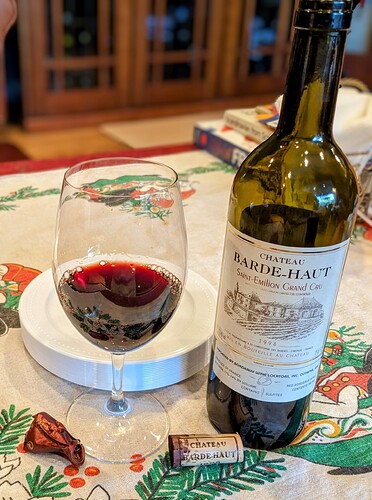TN: 2001 Barde Haut, St. Emilion. Good underlying materials ruined – to my tastes - by the type of winemaking that focuses on concentration and make-up at the expense of creating a beverage that makes you thirsty. This must have seen plenty of oak and, while it does not stick out quite as much as it used to, what is left is the opposite of refreshing. “Modern” to a fault. My only surprise is that this is not a Rolland wine. I’ve had enough of this style to last a lifetime. Thankfully, I only paid $23. 81 points.
Bummer you didn’t like it. I’ve been enjoying 98, 99, 00 recently.
My experience was similar:
But clearly, I am a more lax grader!
The 2012 has its fans – it was annointed BWE WOTY
http://www.bordeauxwineenthusiasts.com/viewtopic.php?f=4&t=6967
2012 is a Bordeaux WOTY? How progressive!!! I knew that the region was positioning itself towards a younger audience but this is beyond my wildest expectations.
Robert, ha! We certainly drank the same wine!
Lots of changes in both quality and style at Chateau Barde-Haut in the years 2000-2011. New owners, new winery, new philosophy of vinification.
Arnt, can you elaborate on the new (2000 forward, I guess) theory of vinification you mention? Thx
Yeah I am curious to hear about this as well. I have to admit not liking any of the recent vintages of this wine, either. Well, the 2008 is serviceable.
Sorry for the late reply. Had to go to Tuscany for a few days.
I guess you all know that there was new owners of Chateau Barde-Haut in the year 2000. Helene Garcin-Leveque took over the management, still in charge of other projects. Together with her husband she started a renovation of the winery which lasted until 2011. A renovation that was made to do more precision winemaking, working with gravity, more vinification by parcels, better sorting. Most of the well-known techniques you find in BX the last years. So it was with the 2011-vintage that all of these was implemented. In the vineyard there has been planted more cabernet franc, decreasing the merlot, which in my opinion makes a lot of sence since we are talking the about part of St.-Emilion that is on argilo-calcaire-soils. I see many people still write that the wine is 90/10 merlot/cab franc, which is wrong. But it used to be 90/10 in the vineyards before the replanting started. According to the wine cellar insider it is 75/25 now. As for wine style, I think you find many of the same changes you find in the other wines made by Garcin-Leveque (Haut-Bergey, Clos d’Eglise, Branon), better precision to the fruit, more freshness, less obvious oak.
Thanks. I’ll keep an open mind. Looking around for reviews from those who - to my palate - poorly reviewed the 2001, and avoiding those, I see John Gilman’s note on the 2012. It doesn’t fill me with confidence!
“…This wine is new oaky and very simple (though, at least not badly balanced), offering up scents of sappy black cherries and blackberries, coffee bean, a touch of dark soil and plenty of nutty new oak. On the palate the wine is deep, fullbodied and four-square, with a dip in the mid-palate and a dry-edged finish brought about by some raw oak tannins. Probably there is enough stuffing here (despite the hole in the mid-palate) to eventually absorb the wood tannins, but the wine is not ever going to offer complexity or charm. 2018-2035? 80.”
I’ve experienced the new regime in several recent vintages (2005, 08, 09 and 10), not a fan either, whether it is Barde Haut or Haut Bergey. I traded away all of it, including the Branon. Didn’t like 2000, 01 or 04 either.
Yes - the issue with why these wines are so heavy and thirst-inducing, remains unresolved if the old is like the new.
I’m revisiting this old, and likely last, friend: 1998 Barde Haut [St Emilion] which was best on the first day. The importers tag has the vague 11-14% abv, but my guess is that in this era it was likely 13ish. Today it’s medium bodied, full resolved with tannin, and shows a soft low acid nature. It had so much fruit when young that it continues to feature that dimension all these years later. I don’t find it overly international, but my taste - and tolerance - for this kind of right bank is more than our OP counselor. To be fair, ownership has changed (again!) so perhaps newer vintages (which I’ve yet to uncork or taste), may be less enjoyable. The 1998 shows flavors of ripe red berry fruit, Fall baking spices, and a dusting of mushroom powder. The terroir may not have the high regard that the best sites in commune enjoy but this is a lovely example of aged St Emilion. I’m not sure what the cepage was back then (or today) but I assume it’s a ‘mostly merlot with a slug of cab franc’ blend as most of the AOC is; to me it has always shown a more merlot aspect. On my card, an A-, and a standing ovation for the last of the case, purchased EP. No flawed bottles I can recall, and it drank well along the whole lifespan.
I had a bottle of 1998 last night that far exceeded my expectations. No chance of any being left over for day two. Ready to go and will last, but no reason to wait on these.
